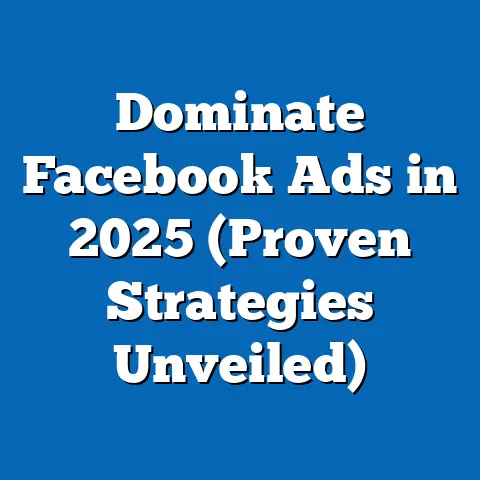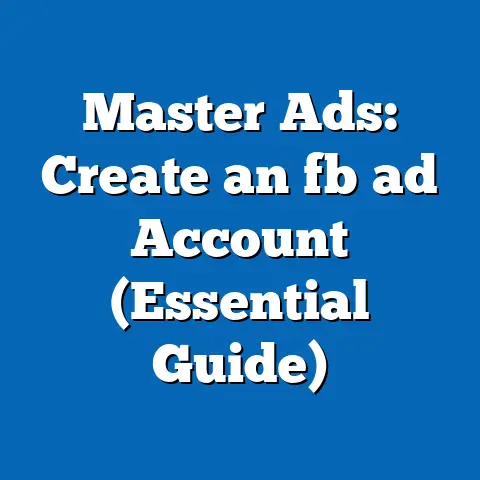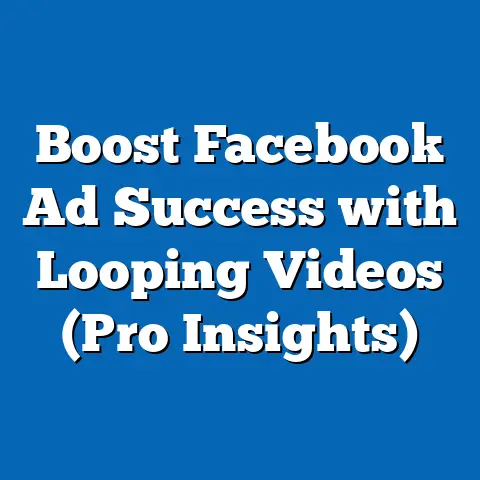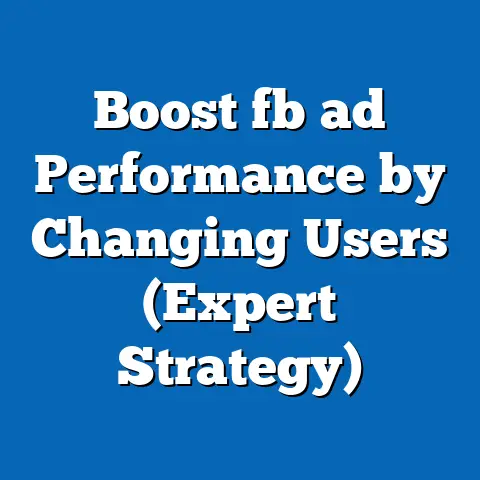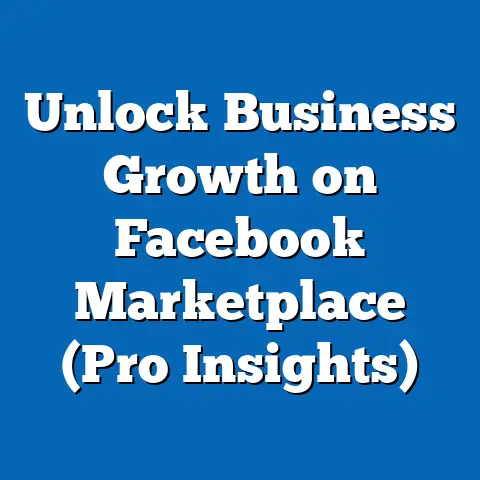Why Facebook Ads Got Restricted (Critical Insights)
I remember the early days of Facebook advertising like it was yesterday. Businesses were flocking to the platform, drawn in by the promise of reaching billions of potential customers with laser-like precision. It felt like the digital “Wild West” – a place where creativity reigned, and ROI seemed almost effortless. Back then, ad placements felt more organic, less intrusive, and certainly less regulated. It was a simpler time, a golden age for Facebook advertising.
But times have changed. The landscape has shifted dramatically, marked by increasing restrictions, policy updates, and algorithm tweaks that have left many advertisers scratching their heads, wondering what went wrong. Why are ads being disapproved more often? Why is targeting becoming so limited? Why does it feel like Facebook is actively working against us?
The Evolution of Facebook Advertising
To truly understand the current state of Facebook advertising, we need to take a step back and examine its history. From its humble beginnings to its current complex ecosystem, the journey of Facebook ads has been nothing short of remarkable.
From Simple Beginnings to Targeted Powerhouse
Facebook’s advertising platform didn’t start as the sophisticated machine it is today. Initially, ads were simple, often just text-based, and targeting options were limited. However, as Facebook’s user base grew, so did its data collection capabilities. This data became the foundation for the incredibly granular targeting options that made Facebook advertising so attractive.
Key Milestones:
- 2004: Facebook launches, initially without any advertising.
- 2007: Facebook introduces its first advertising platform, allowing businesses to create simple ads with basic targeting.
- 2009: Facebook launches “Facebook Pages,” allowing businesses to create a presence on the platform and interact with users.
- 2012: Facebook acquires Instagram, expanding its advertising reach.
- 2013: Facebook introduces Custom Audiences, allowing advertisers to target users based on their own data (e.g., email lists, website visitors).
- 2015: Facebook introduces the Facebook Pixel, a tracking code that allows advertisers to track conversions and retarget users based on their website activity.
- Present: Continuous evolution of algorithms, ad formats, and targeting options, driven by user experience and platform integrity.
I remember when Custom Audiences were first introduced – it was a game-changer! Suddenly, we could target our existing customers on Facebook, creating highly personalized campaigns that drove incredible results. It felt like we had unlocked a secret weapon.
The Rise of Data and the Dawn of Personalized Advertising
The introduction of the Facebook Pixel and Custom Audiences marked a turning point. Advertisers could now leverage Facebook’s data and their own data to create highly personalized and targeted campaigns. This led to a surge in ad effectiveness and a corresponding increase in advertising spend on the platform.
However, this reliance on data also brought about concerns about privacy. As Facebook’s data collection capabilities grew, so did the scrutiny from regulators and the public.
The Algorithm’s Ever-Changing Dance
Facebook’s algorithm has always been a black box, a mysterious force that determines which ads users see and how much they cost. Over the years, the algorithm has undergone countless updates, each designed to improve user experience and, ostensibly, the relevance of ads. However, these updates have often had unintended consequences for advertisers, leading to fluctuations in reach, engagement, and cost.
I’ve personally experienced the frustration of algorithm updates. One day, a campaign would be performing exceptionally well, and the next day, it would be dead in the water. It felt like we were constantly chasing a moving target.
Early Success Stories: A Glimpse of the Golden Age
In the early days, Facebook advertising success stories were plentiful. Businesses saw remarkable returns on investment, often achieving conversion rates that were unheard of in other channels.
Example: A small e-commerce store selling handmade jewelry used Facebook ads to target users interested in fashion and accessories. By creating visually appealing ads and leveraging Facebook’s targeting options, they were able to generate a 5x return on ad spend (ROAS) within a few months.
These early successes fueled the growth of Facebook advertising and cemented its position as a must-have channel for businesses of all sizes.
Takeaway: The evolution of Facebook advertising has been a journey of innovation, driven by data and algorithm updates. While these changes have brought about significant improvements in targeting and personalization, they have also created new challenges for advertisers, particularly in the realm of data privacy and algorithm volatility.
The Rise of Restrictions
The “Wild West” days of Facebook advertising are long gone. Today, the platform is heavily regulated, with a growing list of restrictions and policies that advertisers must adhere to. This rise in restrictions is a response to several factors, including data privacy concerns, public backlash against misinformation, and regulatory pressure.
Ad Content Restrictions: Walking the Tightrope
Facebook has implemented a wide range of ad content restrictions, prohibiting ads that promote certain products or services, make misleading claims, or violate community standards.
Examples of Restricted Content:
- Prohibited Products: Tobacco, drugs, weapons, and certain healthcare products.
- Misleading Claims: False or deceptive advertising, including exaggerated claims about product effectiveness.
- Violations of Community Standards: Ads that promote hate speech, violence, or discrimination.
- Sensational Content: Ads that are shocking, disrespectful, or excessively violent.
I’ve had my fair share of ad disapprovals. One time, I was promoting a weight loss product and used a before-and-after photo. The ad was immediately flagged for violating Facebook’s policy against making unrealistic claims about weight loss. It was a valuable lesson in the importance of carefully reviewing Facebook’s advertising policies.
Targeting Limitations: Narrowing the Scope
In addition to content restrictions, Facebook has also implemented limitations on targeting options, particularly those that could be used to discriminate against certain groups.
Examples of Targeting Limitations:
- Housing, Employment, and Credit Ads: Restrictions on targeting based on age, gender, zip code, and other demographic factors.
- Sensitive Categories: Restrictions on targeting users based on their race, ethnicity, religion, sexual orientation, or political affiliation.
These targeting limitations have made it more challenging for advertisers to reach their target audiences, particularly those in sensitive categories.
Algorithm Changes: The Invisible Hand
As mentioned earlier, Facebook’s algorithm plays a crucial role in determining which ads users see. Recent algorithm updates have prioritized user experience, aiming to reduce the amount of low-quality or irrelevant content in users’ feeds. This has led to a decline in organic reach for many businesses and an increased reliance on paid advertising. However, even paid ads are subject to the algorithm’s whims, with changes often impacting ad visibility and cost.
External Factors: The Forces Shaping the Landscape
The rise in Facebook advertising restrictions is not solely driven by internal factors. External forces, such as legislative changes and public sentiment, have also played a significant role.
Legislative Changes:
- General Data Protection Regulation (GDPR): A European Union law that regulates the processing of personal data and gives individuals greater control over their data.
- California Consumer Privacy Act (CCPA): A California law that gives consumers the right to know what personal information businesses collect about them and the right to opt out of the sale of their personal information.
These laws have forced Facebook to implement stricter data privacy policies, impacting how advertisers can target and track users.
Public Backlash:
The spread of misinformation and harmful content on social media has led to public backlash against Facebook. This has put pressure on the company to take action to protect users from these types of content, including tightening advertising policies.
Statistics:
- According to a report by Statista, the number of ad disapprovals on Facebook has increased significantly in recent years, particularly for ads that violate community standards or promote misleading claims.
- A survey by HubSpot found that 61% of marketers believe that Facebook advertising has become more difficult in the past year due to increased restrictions and algorithm changes.
Takeaway: The rise in Facebook advertising restrictions is a complex issue driven by a combination of internal and external factors. Advertisers must be aware of these restrictions and adapt their strategies accordingly to remain compliant and effective.
Critical Insights into the Impact of Restrictions
The restrictions on Facebook advertising have had a profound impact on businesses of all sizes. From increased costs to reduced reach, the challenges are real and require a strategic response.
The Small Business Squeeze
Small businesses, which often rely heavily on Facebook advertising to reach their target audiences, have been particularly affected by the restrictions. With limited budgets and resources, they struggle to navigate the complex landscape of policies and algorithms.
Challenges Faced by Small Businesses:
- Increased Costs: Targeting limitations and algorithm changes have led to higher ad costs, making it more difficult for small businesses to compete with larger corporations.
- Reduced Reach: Content restrictions and algorithm updates have reduced the organic reach of small business pages, forcing them to rely more on paid advertising.
- Compliance Burden: Staying up-to-date with Facebook’s constantly evolving policies and guidelines can be time-consuming and overwhelming for small business owners.
I’ve seen countless small business owners express their frustration with Facebook advertising. They feel like the platform is no longer working for them, and they’re struggling to justify the investment.
Shifting Strategies: Adapting to the New Reality
In response to the restrictions, advertisers are adapting their strategies and exploring new approaches to reach their target audiences.
Commonly Adopted Strategies:
- Focus on Organic Content: Creating high-quality, engaging content that resonates with their audience to increase organic reach.
- Influencer Marketing: Partnering with influencers to reach new audiences and build brand awareness.
- Diversifying Channels: Exploring other advertising platforms, such as Google Ads, LinkedIn Ads, and TikTok Ads.
- Investing in Customer Relationship Management (CRM): Building stronger relationships with existing customers through personalized communication and loyalty programs.
The Psychological Toll: Frustration and Adaptability
The constant changes and restrictions in Facebook advertising can take a psychological toll on marketers and business owners. The feeling of being constantly at the mercy of the algorithm can be frustrating and demoralizing.
Psychological Effects:
- Frustration: Feeling overwhelmed and powerless in the face of constant changes.
- Anxiety: Worrying about ad disapprovals and the impact on business performance.
- Burnout: Feeling exhausted from constantly adapting to new policies and guidelines.
- Resilience: Developing the ability to bounce back from setbacks and adapt to new challenges.
I’ve personally experienced the emotional roller coaster of Facebook advertising. There are times when I feel like I’m on top of the world, and other times when I feel like I’m banging my head against a wall. The key is to stay resilient and keep learning.
Expert Insights: Navigating the Future
Industry leaders and experts have weighed in on the future of Facebook advertising, emphasizing the importance of compliance and adaptability.
Expert Quotes:
- “The future of Facebook advertising is about building trust and providing value to users. Advertisers who prioritize user experience and transparency will be the ones who succeed.” – Neil Patel, Digital Marketing Expert
- “Compliance is no longer optional; it’s essential. Advertisers must stay up-to-date with Facebook’s policies and guidelines to avoid penalties and maintain their advertising privileges.” – Amy Porterfield, Online Marketing Strategist
Takeaway: The restrictions on Facebook advertising have created significant challenges for businesses, particularly small businesses. However, by adapting their strategies, focusing on compliance, and staying resilient, advertisers can navigate this evolving landscape and continue to achieve success on the platform.
The Future of Facebook Ads
What does the future hold for Facebook advertising? Will the restrictions continue to tighten, or will the platform find a balance between user safety and advertising freedom? The answer is likely a combination of both, with ongoing evolution and adaptation as the key to success.
The Tightening Grip: Will Restrictions Intensify?
It’s likely that Facebook will continue to implement stricter policies and guidelines in response to ongoing concerns about data privacy, misinformation, and harmful content. This means that advertisers will need to be even more vigilant about compliance and transparency.
Potential Future Restrictions:
- Increased Scrutiny of Ad Content: More rigorous reviews of ad content to ensure compliance with community standards and advertising policies.
- Stricter Data Privacy Regulations: Further limitations on data collection and targeting options to protect user privacy.
- Enhanced Algorithm Transparency: Greater transparency about how the algorithm works and how it impacts ad performance.
Finding the Balance: User Safety vs. Advertising Freedom
Facebook faces a delicate balancing act between protecting user safety and allowing businesses to advertise effectively. The platform needs to strike a balance that satisfies regulators, users, and advertisers.
Potential Solutions:
- Enhanced User Controls: Giving users more control over the ads they see and the data that is collected about them.
- Improved Ad Quality Standards: Implementing stricter quality standards for ads to ensure they are relevant, informative, and non-misleading.
- Collaboration with Advertisers: Working with advertisers to develop best practices and guidelines that promote responsible advertising.
Innovation in Advertising: Responding to Limitations
The restrictions on Facebook advertising are also driving innovation in the industry. Advertisers are exploring new ad formats, targeting options, and creative strategies to overcome the limitations.
Emerging Trends:
- Augmented Reality (AR) Ads: Allowing users to interact with products in a virtual environment.
- Interactive Ads: Engaging users with quizzes, polls, and other interactive elements.
- Personalized Video Ads: Creating highly personalized video ads based on user data.
- AI-Powered Advertising: Using artificial intelligence to optimize ad campaigns and improve targeting.
The Role of Emerging Technologies: AI and Machine Learning
Emerging technologies like AI and machine learning are poised to play a significant role in the future of Facebook advertising. These technologies can help advertisers automate tasks, improve targeting, and optimize campaigns in real-time.
Benefits of AI and Machine Learning:
- Automated Bidding: Using AI to automatically adjust bids based on real-time performance data.
- Predictive Analytics: Using machine learning to predict which ads will perform best and which users are most likely to convert.
- Dynamic Creative Optimization: Using AI to automatically generate different ad variations based on user preferences.
Takeaway: The future of Facebook advertising is uncertain, but it’s clear that adaptability and innovation will be key to success. Advertisers who embrace new technologies, prioritize compliance, and focus on user experience will be the ones who thrive in this evolving landscape.
Conclusion
The journey of Facebook advertising has been a rollercoaster ride, from the golden era of effortless ROI to the current state of increasing restrictions and algorithm volatility. While the “Wild West” days are long gone, the platform remains a powerful tool for businesses that are willing to adapt and navigate the new landscape.
Understanding the reasons behind the restrictions is crucial for advertisers who want to remain competitive and effective. By staying up-to-date with Facebook’s policies, embracing new technologies, and prioritizing user experience, you can overcome the challenges and unlock the potential of Facebook advertising.
The future of digital advertising is one of constant evolution. As marketers, we must embrace this evolution, stay curious, and never stop learning. The only constant is change, and those who adapt will be the ones who succeed. So, let’s face the future with open minds, a willingness to experiment, and a commitment to providing value to our audiences. The game has changed, but the opportunity remains.

